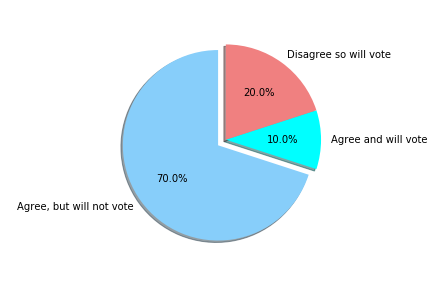This is much inspired by a Dutch blog post of Prof. Casper Albers of the Rijksuniversiteit Groningen.
In the Netherlands we had a so-called advise-giving referendum law from 2015-2018 [1]. This law allows any Dutch national to request a national referendum about adopted laws or approval of treaties. The advice-giving in advice-giving referendum means that it gives advice to the ruling parties. So they don't have to act on it. This is something which I could probably write a whole blog post about but in this post I just want to write about the a problematic game-theory problem underlying this Dutch referendum law.
The referendum rules
A referendum will be held if a certain number of signatures are collected which support a referendum. In this case it is 300.000 signatures which is about 2.5 percent of the total population that can vote [1]. This is already a pretty bad idea because a pretty small minority can demand a referendum. But there are more problems ahead. The result of the referendum is determined by the voter majority, however, if the turnout is less than 30 percent of the total population then whatever the result is it will be declared invalid. From a theoretical perspective this is ok if you make the assumption that a representative part of the population will vote. But is this the case?
Voter strategy
For a better understanding let's just view it from the perspective of the voter. So suppose the government has adopted a new law and there will be a referendum to see if the country's nationals agree. If I disagree with this new law I will definitely go and vote against it. But suppose now that I agree with the new law. Then, I have two options: I can vote in support of the law or if I suspect that the voter turnout is below 30 percent then I can also decide to not vote. So this voter has two options which means that to have a fair end-result the voters which agree with the law have to decide on a strategy together. This is a burden which only applies to the agree-voter and not to the disagree-voter. That the agree-voters can self-organise is not evident. Of course if only the 2.5 percent threshold which was needed to have a referendum turn up this is no problem. But if you have about a 30 percent turnout things can get pretty bad. For example you could get something like this:

Image made by me
So the underlying issue is related to a game-theory problem called the Prisoner's dilemma[3] which I won't write about since it might bore people :P
What happened in the Dutch referendum?
The result of the first advice-giving referendum was actually pretty close to what you saw in the pie-chart. We had about 32.5 percent voter turn out and of this 32.5 percent the majority voted against. Altough it should be noted that we can only guess what that remaining percent of people that didn't turn up wanted, from the earlier strategy it seems very plausible that they were not opposed. Most Dutch politicians also realised that the referendum rules did not work well in a real-world scenario. So it got abolished in 2018 [1].
Improvements are needed
There are a couple of ways that this type of referendum can be improved. The obvious one is increase the referendum threshold and voter turnout. You could also view people who did not decide to vote as a seperate group in the voting process. So if 70 percent of people did not vote this means that they were not actively opposed to it.
More generally XD
In general elections this type of problem can occur if there is a two-party system where the votes for a single party is determined by not wanting the other party. This probably was a factor in the Hillary-Trump USA elections in 2016. If you increase the number of parties it is expected that this affect decreases since your options increase. In a sense, this type of problem occurs because the possibilities are restricted.
References
[1] https://www.parlement.com/id/vh8lnhrsk1yn/referendum
[2] http://blog.casperalbers.nl/other/het-referendum-van-geenpeil-en-het-prisoners-dilemma/
[3] Read this if you love your technical stuff https://plato.stanford.edu/entries/prisoner-dilemma/ if not just youtube prisoner dilemma
Join #steemSTEM
#steemSTEM is a community project with the goal to promote and support Science, Technology, Engineering and Mathematics related content and activities on the STEEM blockchain. If you wish to support the #steemSTEM project you can: Contribute STEM content using the #steemstem tag | Support steemstem authors | Join our curation trail | Join our Discord community | Delegate SP to steemstem
Convenient Delegation Links:
50 SP | 100SP | 500SP | 1000SP | 5000SP | 10000SP | 50000SP

Image courtesy: Me ;)